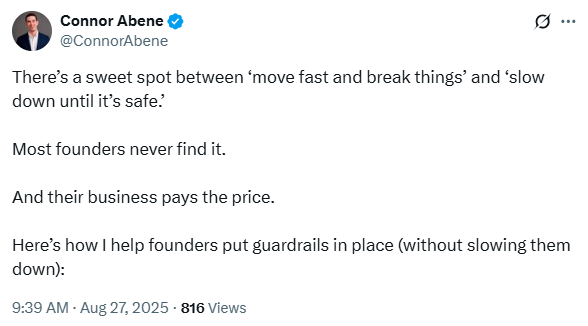Take Five #173: ETA model analysis exploring the mechanics of traditional, self-funded, and HoldCo approaches, and more
Top five must-reads this week in the world of SMB acquisitions and operations
Subscribe to Take Five to get our top 5 quick weekly reads on the world of SMB, M&A, and EtA from the team at Kumo. Kumo aggregates hundreds of thousands of deals into one easy-to-use platform so that you can spend less time sourcing, and more time closing deals.
Take Five is created and sponsored by Kumo, a powerful deal aggregator to help supercharge your deal sourcing at withkumo.com.
What can you do with Kumo?
Browse 120,000+ deals from hundreds of brokers and every major marketplace, with 700+ unique deals added daily.
Save time and stop reviewing duplicate deals. Kumo matches identical deals across hundreds of sources so you can view unique business opportunities, even if they’re slightly different across different websites.
Get a daily email for deals that match your search criteria.
Take Five #173: ETA model analysis exploring the mechanics of traditional, self-funded, and HoldCo approaches, and more
👉 Upcoming Event: Buy Then Build Summit | Sept 24-26
The world of ETA has changed.
Kumo CEO Jason Pratts is joining the Buy Then Build Summit this September in St. Louis to talk about what Search 2.0 really means — and how it’s reshaping deal flow, capital, and community for acquisition entrepreneurs.
If you’re buying or building, this is the future.
Use discount code KUMO to get $650 off your ticket!
1. How to balance business growth and caution with a practical financial framework
2. “Other Income” line item can turn a fair deal into a bad one
3. ETA model analysis exploring the mechanics of traditional, self-funded, and HoldCo approaches
1. The Traditional Search Fund
The traditional search fund is the oldest and most structured ETA model. It was first formalised at Stanford in the 1980s and has since grown into a well-understood path, especially in the U.S.
How it works:
You raise a small pool of capital (the “search fund”) from a group of investors.
These investors will finance your search, covering your salary, deal expenses and due diligence.
Once you find a company, the same group of investors (or their network) funds the acquisition.
Post-acquisition, you step in as CEO.
Governance dynamics:
This model comes with built-in structure. Because investors back you from day one, they typically require formal governance mechanisms such as a board of directors, structured reporting, and veto rights on major decisions. From my MBA interviews, acquirers described their boards as both mentor and watchdog. One founder put it bluntly: “I wanted autonomy, but I quickly realised I’d signed up for a corporate-style boardroom.”
The advantage is clear: you gain seasoned advisors and financial backers who are deeply aligned with your success. The trade-off is autonomy. Investor boards can prevent costly mistakes, but they can also slow decision-making.
Read Alexander Kelm’s post here.
4. Dead deal fees are avoidable when you source wisely and negotiate protections early
Legal Protections to Reduce Financial Risk
Proactive strategies are a great start, but legal protections provide an additional layer of security for your investment, helping to manage unforeseen risks. By establishing clear agreements and relying on expert legal advice, you can better navigate the complexities of a deal and avoid unnecessary financial setbacks.
Creating Clear Contractual Agreements
Well-defined contracts are essential to protect your interests. Start by outlining key fee triggers in your purchase agreement to clearly establish exit conditions. For instance, you can specify scenarios like major changes in business performance or the discovery of hidden liabilities.
Consider including reverse termination clauses, which require the seller to cover your due diligence costs if they back out without valid cause. Escrow arrangements are another useful tool - holding a portion of the purchase price in escrow ensures that critical milestones are met before full payment is released.
To manage unexpected costs, negotiate due diligence cost caps, which limit your financial exposure. Additionally, material adverse change clauses can give you an out if the business experiences a significant downturn between the signing and closing stages of the deal.
5. Yale SOM Case Study: “Managing Blue-Collar Team Members in a Search Fund–Acquired Business”
As a reference point, in the 2024 Stanford Graduate School of Business Search Fund Study, of the 58 search funds that acquired a company through the traditional search fund model in the 2022–2023 cycle, 31 (53 percent) were categorized as having at least some blue- and pink-collar employees. We would go as far as to say that almost all ETA operating companies have a healthy dose of manual labor roles, except for the software-as-a-service (SaaS) players, who might think they can avoid this topic. However, they often have a swath of pink-collar roles. Blue-collar businesses were quite popular during the Search 1.0 era, but there has been a shift toward more technology-focused companies (Search 2.0). Despite this, blue-collar companies still seem common among self-funded searches, at least based on anecdotal evidence.
We believe this is a pertinent topic because many ETA impresarios are hyper pedigreed and have advanced through a series of elite academic institutions and prestigious employers—mainly professional service firms or capital providers—before becoming CEOs of lawn care companies. They have rarely worked alongside, let alone managed, blue-collar workers. Our students and ETA CEOs are Excel jockeys; they do not turn the wrench like blue-collar maestros. The closest they might have come is when they were associates at private equity firms working on a few industrial services deals. We acknowledge that there is one demographic that may not fit neatly into our framework—the military veterans. They often have experience working with and leading entry-level soldiers, who are the equivalent of blue-collar personnel.
Nonetheless, we are optimistic that our students can adapt and learn how to be terrific CEOs for their teams, including both blue- and pink-collar workers. Searchers regularly acquire businesses in sectors such as porta-potty rentals, septic services, landscaping, and other home-service trades where people, not products, drive results. Success in these industries hinges on effectively leading the frontline blue-collar band, and ignoring cultural mismatch can lead to employee turnover, resentment, safety problems, and costly operational failures. Managing the blue-collar team is not a peripheral concern; in most service-heavy ETA deals, it is the whole game, so treating labor as just an input is a sinful mistake that can cause a massive loss of trust and value.
Read the rest of the Yale SOM paper here.
Loved what you read? Subscribe to Take Five to get our top quick reads every week from the team at Kumo. Kumo aggregates thousands of sources into one easy-to-use platform so that you can spend less time sourcing, and more time closing deals.







